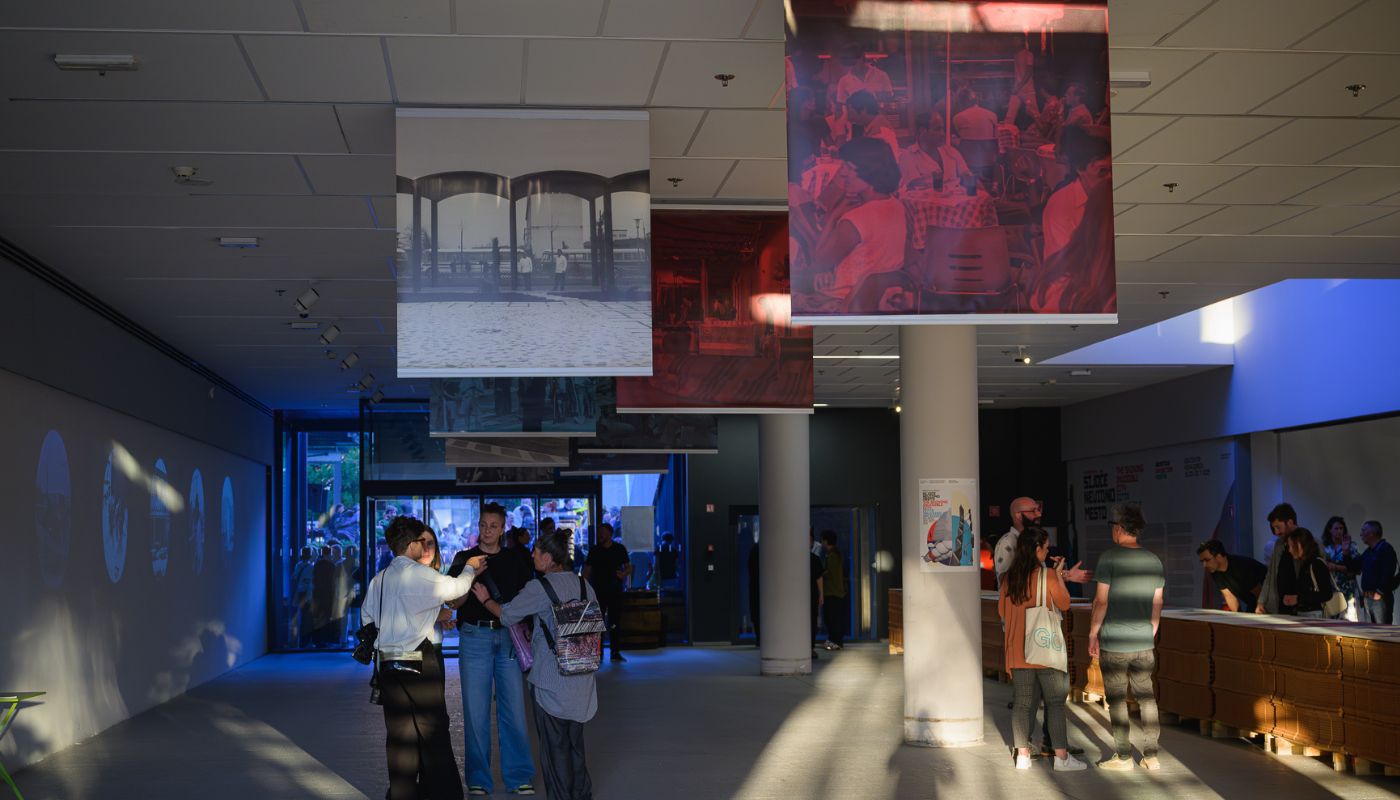
SHINING INVISIBLE PLACE
by EVA SUŠNIK AND MILOŠ KOSEC
Cities throughout history have been formed slowly, organically, with centuries or millennia of layering, including demolition. When we visit old cities, we admire all these layers from different periods and wonder about them, how and when they were formed and why they are the way they are.
Nova Gorica, on the other hand, is a very young and very small city. Layers of history in space are layered in archives more than in old walls and archaeological sites. Photography and modern archiving are contemporary of Nova Gorica and have accompanied it since 1948. Therefore, we can understand how and when the different spatial layers were created, as well as which ones did not arise or remained unrealized. The city is a clear, simple, manageable example for an analytical approach to space. Since this is a recent history and a purpose-built site (not organic) from the beginning, there is consistent traceability of sources in the archives. Nova Gorica is an excellent example for evaluating the success of given architectural projects and for finding answers to the question “what to do to do?” (were successful). (from the text Nova Gorica after 35 years, text from 1984, published in AB, written by the author of the urban design of the city, Edvard Ravnikar: “Today it is bitter to say that Nova Gorica, as a pioneering idea, did not succeed, and therefore the question arises as to what to do in order to do so.)
To some, Nova Gorica seems to be a city of missed opportunities, because from the very beginning the development did not follow the original Ravnikar’s urban plan from 1948, some do not like the modernist expression of the buildings and prefer to look across the border towards historical and neo-historical examples, some like the climate and lush urban greenery. But almost certainly, the common point of all views is that the city still, after 78 years, seems somewhat unfinished. Today, on a walk through the city, we come across voids, missing buildings and never-finished arrangement of public space, which give Nova Gorica the image of a never-completed construction site. However, incompleteness can also be read as the city’s openness to its own future.
In an interview conducted for the exhibition, architect Vinko Torkar said: “That something is unfinished, or that it is not concreted, can also be very good. For example, Ravnikar’s plan for Nova Gorica also envisaged a railway line that would run through the old town of Solkan and along the edge of Kekec (then St. Catherine). The great architects obviously consider themselves omnipotent, erasing with a wave of their hands: Ravnikar the old core of Solkan, Plečnik the Ljubljana Castle for the new parliament, and Le Corbusier half of Paris in the name of the “modern” city. If we had built this city more successfully, we would never have had such a beautiful and unique meadow as the city centre.”
However, the incompletion of the projects started, the demolition of already existing premises and, above all, the numerous premises that have never left the papers with architectural plans and have embodied in space, are not necessarily just signs of failure. It seems that the spaces that live only in the archives can be similar to the voids on construction sites and in ruins for life in the city. These may be architectures that are not perfect, but precisely because of their imperfection, they allow everyone to build on them and complete them in their own way through their use, intervention, thinking, imagination. Similarly, the lawns and parking lots in a never-completed city are transformed from abandoned building plots into important and living spaces with their own history and future, if we are aware of all their alternative lives that reside in the archives. Therefore, the emptiness of the city is also the spaces of thinking and living in the city – without empty spaces, the city would not breathe, nor would it have the opportunity to constantly improve and adapt to its inhabitants. The voids in a city are never really empty, but are sometimes even more full of meanings, memories and never-realized futures than walled plots and used buildings.
The Shining Invisible City project explores precisely those projects that were conceived with a love of space, but are currently invisible in physical space for various reasons. Either they are not there because they are demolished, or the projects were never implemented, never completed, or were eventually abandoned. The project maps the shiny invisible points of the city – which today do not shine from paper into space, as some did in the past before they were demolished, and some may yet shine into the future. Unrealized plans are never just a document of some failure, but sometimes even more than the constructed buildings, they are a testimony to the never-completed formative ideas of the creators of space, which do not give us peace even three quarters of a century after their creation. On the one hand, the large number of unimplemented projects indicates a broad engagement with space and many deep considerations, including a love of space. On the other hand, these invisible, shiny spots are also a possible potential for development in the future and show that urban planning never starts on a blank sheet of paper.
The universal layer of the exhibition is the realization that unfinished architectural projects are often unfinished at the expense of public space and the so-called central activities. And these are actually spaces that are city-forming and that “make the city.” These are spaces for meeting, sitting, running errands, socializing, shopping, … Incompleteness at the expense of public space creates the degradation of space in general, encourages semi-private use, abandonment or inappropriate other facilities (parking lot, waste, ecological island, emptiness, …). Such a space also has a negative impact on the surroundings, where often the same non-content continues. For this reason, it would be indicated, in harmony with a sustainable approach, when rescuing and arranging degraded spaces, to look at the stage of completion and use of the surrounding spaces.
One of the public or semi-public spaces in the city, which has a great, but not yet fully exploited potential, is the Eda tower, from the construction onwards, stories have been woven around the building, and today many bars on the ground floor, in the very center of the city, are empty. Such is also the passage that connects the busy street near the schools and the quieter pedestrian zone of the city. That is why the exhibition, in the face of the theme it advocates, is itself placed in such a space, with the desire to revive it and indicate its possible use and highlight its advantages. The main element of the exhibition in the wide lobby is a 24-meter-long table, which in some way resembles the line stroke of the Magistrala. It is built of bricks of the Goriška brickworks, which, with their color and materiality, testify to the tradition of frnage in our area and maintain continuity between the source-land and the product-city. Artistically processed architectural projects gathered in one place, through 3D models, video materials and old photographs, build a new, invisible Nova Gorica, which consists of built and unbuilt buildings, of bricks and ideas.
The first urban planner of Nova Gorica, Edvard Ravnikar, wrote for the competition for the arrangement of the city centre in 1968: “It is not possible to make a beautiful city out of small and insignificant wishes.” And although he may have been disappointed when he reviewed the works carried out in Nova Gorica, he wrote so 35 years after the start of the construction of the city, in a famous text published in AB in 1984, but some of his ideas, which turned out to be almost visionary, live on.
The main spatial qualities and characteristics of the city of Nova Gorica, as well as those properties that we have come to know as positive, all stem from Ravnikar’s thought: a network of parallel and transverse streets, the pavilion placement of buildings in a space surrounded by greenery, integration into the landscape context with emphasized views of Mount Athos, Sabotin and Kapela, and above all (increasingly?) a current, strong and clear connection through Erjavčeva Street and Via San Gabriele to Italian Gorizia. Certainly, these are qualities that it shows to value, protect and preserve for the future. Understanding the present and expecting the future is possible only by knowing and respecting the past, including the past of ideas.
The exhibition was prepared by Nonument group in collaboration with architect Eva Sušnik. Nonument Group (Neja Tomšič, Martin Bricelj Baraga, Nika Grabar, Miloš Kosec) is an artistic-research collective that focuses on nonumente – hidden, abandoned, erased or forgotten architecture or public spaces whose meaning has changed due to political or social changes. In collaboration with institutions and independent researchers, the collective maps and archives nonuments around the world. Through her artistic interventions, she explores memories and highlights the tensions revealed by the reactivations of individual nonuments.
The exhibition will be open until November 30, 2025 every day from 07-21 on the ground floor of the Eda Tower in Nova Gorica.
Prvotni jezik tega članka je slovenščina.

